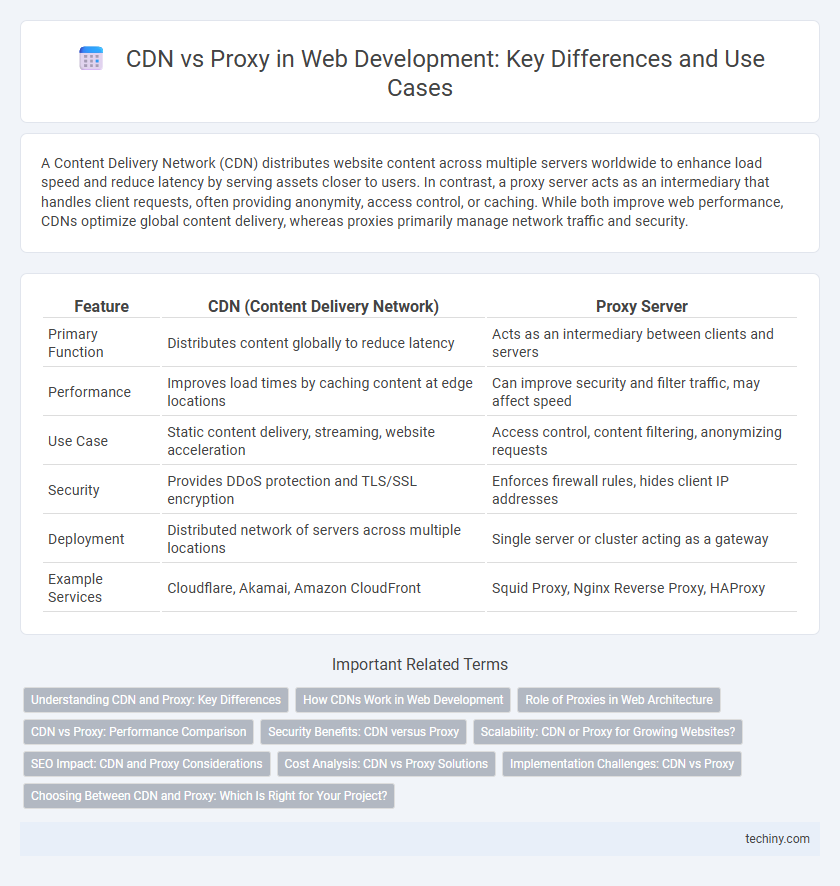A Content Delivery Network (CDN) distributes website content across multiple servers worldwide to enhance load speed and reduce latency by serving assets closer to users. In contrast, a proxy server acts as an intermediary that handles client requests, often providing anonymity, access control, or caching. While both improve web performance, CDNs optimize global content delivery, whereas proxies primarily manage network traffic and security.
Table of Comparison
| Feature | CDN (Content Delivery Network) | Proxy Server |
|---|---|---|
| Primary Function | Distributes content globally to reduce latency | Acts as an intermediary between clients and servers |
| Performance | Improves load times by caching content at edge locations | Can improve security and filter traffic, may affect speed |
| Use Case | Static content delivery, streaming, website acceleration | Access control, content filtering, anonymizing requests |
| Security | Provides DDoS protection and TLS/SSL encryption | Enforces firewall rules, hides client IP addresses |
| Deployment | Distributed network of servers across multiple locations | Single server or cluster acting as a gateway |
| Example Services | Cloudflare, Akamai, Amazon CloudFront | Squid Proxy, Nginx Reverse Proxy, HAProxy |
Understanding CDN and Proxy: Key Differences
Content Delivery Networks (CDNs) optimize web performance by distributing cached content across global servers, reducing latency and improving load times for users. Proxies act as intermediaries that route client requests through a server, enhancing security, anonymity, and filtering capabilities but not necessarily improving content delivery speed. While CDNs focus on accelerating content access by geographically dispersing data, proxies primarily manage network requests and provide control over data flow.
How CDNs Work in Web Development
Content Delivery Networks (CDNs) work in web development by distributing cached website content across a network of globally dispersed servers, reducing latency and increasing load speeds for users regardless of their geographic location. By routing user requests to the nearest edge server, CDNs minimize the distance data travels, which enhances website performance and reliability. This efficient content distribution also helps reduce server load and protects against traffic spikes and DDoS attacks in web applications.
Role of Proxies in Web Architecture
Proxies act as intermediaries between clients and servers, enhancing security, caching, and load balancing within web architecture. By masking client IP addresses and filtering requests, proxies protect web applications from attacks and unauthorized access. Unlike CDNs that primarily optimize content delivery speed globally, proxies focus on managing traffic flow and enforcing security policies within the network.
CDN vs Proxy: Performance Comparison
Content Delivery Networks (CDNs) enhance web performance by distributing cached content across geographically dispersed servers, reducing latency and speeding up load times for global users. Proxy servers primarily act as intermediaries that route client requests, which can provide security and access control but may introduce additional latency compared to CDNs. Overall, CDNs offer superior performance optimization by minimizing round-trip time and efficiently handling static and dynamic content delivery.
Security Benefits: CDN versus Proxy
Content Delivery Networks (CDNs) enhance web security by distributing traffic across multiple servers, mitigating DDoS attacks, and providing built-in Web Application Firewall (WAF) protection. Proxies primarily focus on anonymity and traffic routing, offering limited security benefits compared to CDNs. CDNs also improve data integrity and encryption through SSL/TLS support, making them a more comprehensive security solution for web applications.
Scalability: CDN or Proxy for Growing Websites?
Content Delivery Networks (CDNs) enhance scalability by distributing website content across global edge servers, reducing latency and server load during traffic surges. Proxies primarily route requests through an intermediary server, which can become a bottleneck under high traffic, limiting scalability for rapidly growing sites. For expanding websites, CDNs offer superior scalability through decentralized content delivery and efficient load balancing.
SEO Impact: CDN and Proxy Considerations
CDN (Content Delivery Network) improves SEO by enhancing site speed and reducing latency, which positively affects user experience and search engine rankings. Proxy servers can obscure the original server IP and potentially cause crawlability issues if not properly configured, impacting SEO performance. Proper implementation of CDN ensures faster content delivery across geographies, while proxies require careful management to avoid negative effects on indexing and link equity.
Cost Analysis: CDN vs Proxy Solutions
CDN solutions typically involve higher upfront infrastructure and bandwidth costs compared to proxy servers, but their distributed network reduces latency and offloads traffic more efficiently, potentially lowering long-term expenses. Proxy solutions often incur lower initial expenses, relying on a single server or limited nodes, which may increase bandwidth and maintenance costs as traffic scales. Evaluating total cost of ownership requires analyzing traffic volume, geographic distribution, and performance needs to determine whether CDN's scalability or proxy's simplicity offers better financial efficiency.
Implementation Challenges: CDN vs Proxy
Implementing a CDN involves configuring edge servers globally to cache and deliver content efficiently, which requires managing cache invalidation and SSL certificates across multiple locations. Proxy servers pose challenges in maintaining consistent security policies and handling real-time request routing, often demanding complex load balancing and SSL termination setups. Both solutions necessitate careful monitoring and optimization to address latency, scalability, and fault tolerance in web application delivery.
Choosing Between CDN and Proxy: Which Is Right for Your Project?
Choosing between a CDN and a proxy depends largely on your project's need for content delivery speed versus security and privacy. CDNs excel in reducing latency by caching content across global servers, ideal for websites with high traffic and static assets, while proxies serve as intermediaries that enhance security, control access, and manage requests, crucial for protecting sensitive data. Evaluating factors like geographic distribution, content type, performance requirements, and security needs will guide the optimal choice for your web development project.
CDN vs Proxy Infographic

 techiny.com
techiny.com